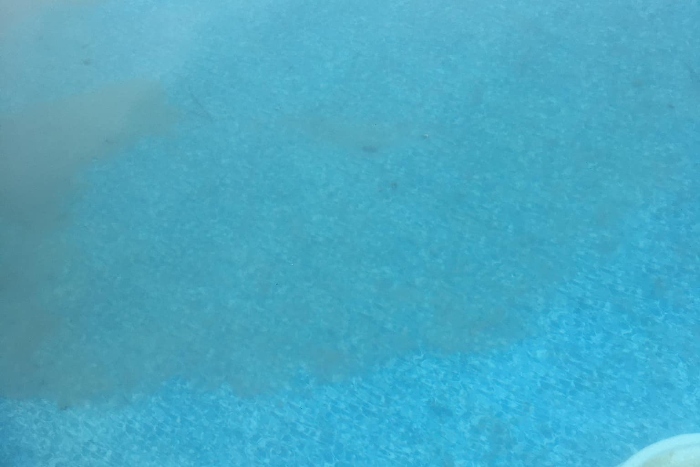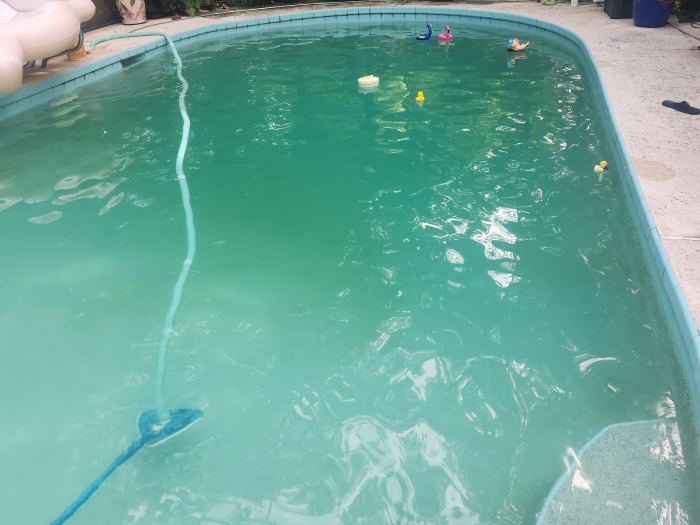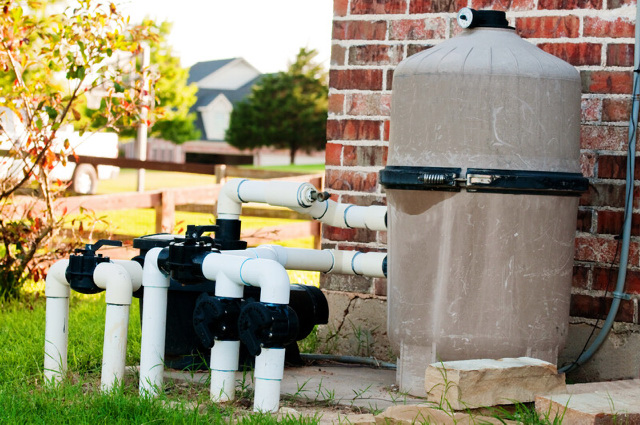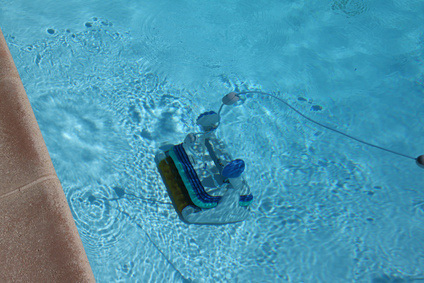
Article Contents
How To Remove Dead Algae? (A 6-Step Guide)
Algae is an unsightly and troublesome problem in any pool and after you kill the algae, the dead algae needs to be removed. Let’s look at the quickest way to remove dead algae.
What You Need To Remove Dead Algae
How To Remove Dead Algae (In 6 Steps)
After killing an algae infestation in your pool, removing algae dust (dead algae) is a straightforward process. This is an important process because the dead algae are unsightly, can cause your pool to look cloudy, and the dust can clog up your filter.
- Turn on the filtration system
Set the multiport valve (if you have one) to “filter.” This will start removing floating algae from the pool’s water. - Brush the Pool Surfaces
Brush the entire surface of your pool (walls, floors, steps, etc.) using overlapping strokes. This will remove any dead algae clinging to the walls and floor of the pool and allow the filtration system and vacuum to remove it. - Skim the surface
Remove floating debris and algae using a fine mesh pool net or scoop. You want to stop some of the dead algae from entering the filter. It will save you from cleaning your filter more than necessary. - Vacuum the Pool
Get out your manual or rechargeable vacuum. If your filter has the option, set it to the “waste” setting. This setting will bypass the filter, and the water will leave the waste port instead. You don’t want to clog up your filter.
Vacuum the entire surface of your pool in overlapping strokes.
Note: if you vacuum to waste, it’s a good idea to put a garden hose in the pool and turn it on as you vacuum, as you’ll lose water when vacuuming. Keep an eye on the water level, too, and stop if it’s below the skimmer. - Clean or replace the filter
The filter will likely be clogged up if you’ve had a lot of algae. Clean it out. You may need to replace it after you have cleared the algae. - Run the pool pump for 24-48 hours
It’s important to filter the water continuously. This is what’s going to clear your cloudy water. Keep an eye on the filter pressure too. If it gets high, the filter is blocked with dead algae. Clean the filter if this is the case, and then filter again.
What Does Dead Algae Look Like
Algae dust is white or gray and will float to the bottom of the pool once the algae is killed. Once the pool is clear again, it will be easy to see. Dead algae resemble sand; brush it if you are unsure what it is. If the water turns cloudy after brushing, it’s algae, but either way, it needs to be vacuumed before it gets into your pool plumbing. Sand will sink to the bottom of the pool, and the water will clear up quickly.
Best Way to Vacuum Dead Algae

The best way to vacuum algae dust is to brush off any algae dust from the pool walls and skim off as much as possible. If you can, use a vacuum with an independent debris chamber so you won’t clog the pool’s filter.
Use a fine mesh bag on the vacuum as many dust particles are minute in size. Vacuum slowly and in overlapping strokes so that the vacuum will touch the entire surface. You should dump out the containment bag often, whether full or not so that the finer particles won’t leech back into the pool.
If you use a vacuum connected to your pool filter, you can set it to “waste” and bypass the filter. This is a great option for algae removal because you don’t want to clog the filter. There is quite a bit of work to do this, but your filter will thank you, and it will save potential filtration issues from coming up.
Can you remove dead algae without a pool vacuum?
Technically, you can brush the algae dust towards the pool drain while the pump is on, and it will suck out most, if not all, of the dust. However, this isn’t good for the filter and can cause circulation issues. It’s best to vacuum out any dead algae dust manually.
There are other ways to remove algae from your pool without a vacuum. It’s important to clean or backwash your filter before and after you filter out the dead algae.
1. Battery or Water Powered Pool Vacuum
If you don’t have a filtration system in your pool or a vacuum, a battery-powered or water-powered algae vac will do the job.
2. Manual Scooping
You can use a net or scoop to remove algae dust, especially in a small area. First, brush the loose algae dust away from the walls and steps. After the dead algae settle on the bottom, scoop it out manually. If the dust is fine, use a flocculant to clump it together, making it easier to scoop.
3. Enzymes
Liquid pool cleaners with enzymes break down the algae dust so they can be filtered out through the pool’s plumbing system. Allow the enzymes to work per the bottle’s instructions for the recommended time. After adding the enzymes, brush the walls and steps of your pool to loosen the algae. You can speed up the process of filtering out the dead algae by sweeping it toward the drain.
4. Pool Brush Attachments
Some pool brushes are designed to be hooked up to a garden hose. The built-in water jets create a high-pressure stream that loosens the algae. The fine algae particles will be filtered out of the pool. You can get this product here:
- No electric power needed
- Collects stones, leaves, dirt, sand & sticks
- Attaches to a standard garden hose
You will, however, need a pool filter and pump to use this process.
Recommended Products:
| Image | Product | Features | Link |
|---|---|---|---|
 |
| 9.7 | Check Price |
 |
| 9.5 | Check Price |
Best Way To Filter Dead Algae
The best way to filter fine algae dust is to clean the pool filter before and after you shock your pool to kill the live algae. Pool cartridge filters contain microfibers inside vertical pleats designed to trap sediment and other debris from your pool.
For normal maintenance, pool filters won’t get clogged if you clean them or backwash them once per month. However, algae is a unique problem; the filter will clog quickly with the recently killed algae and algae dust.
Once it’s clogged, the filter cannot hold the algae dust and will release it back into the water.
Different Filter Types
There are three different types of pool filters: DE, sand, and cartridge. We have discussed cartridge filters above. Just as you would clean a cartridge filter before and after an algae treatment, DE and sand filters need to be back-washed and rinsed in the same manner.
No filter will remove 100% of algae dust, and the more the pool is shocked, the finer the dead algae is, which exacerbates the problem. You should always vacuum algae dust along with filtering it out.
Will My Sand Filter Remove Dead Algae?
Sand filters will remove dead algae but not as well as a DE or cartridge filter. Sand filters are the least likely to get clogged with algae because they only use sand, not pleats, to filter out debris and particles. The slotted lateral pipes constantly force water over the sand (when it’s running), making it easier to flush out sediment than other types of filters.
The downside to sand filters is that they only filter down to about 75 microns, which means the filter can leave behind debris that is visible to the naked eye leaving your pool cloudy. As with any pool filter, it should be back-washed and rinsed after all algae treatments and once per month to help prevent algae growth.
Although sand filters don’t filter as well, after large algae problems, you’ll still need to backwash the filter several times to keep it clear and operating correctly.
Will My DE Filter Remove Dead Algae?

De filters are the best filters for swimming pools and filtering algae. They are also the most expensive. DE filters work by forcing water through the diatomaceous earth, which traps the debris and algae. DE filters trap the smallest debris particles from 5 microns, much smaller than a sand filter’s 75-micron filtering.
DE filters clog up faster than the other two filters, but this is good. If the DE filter is getting clogged, the pool is getting clean. While removing algae dust, keep an eye on the pressure gauge of your DE filter.
The normal filter range is 8-12 PSI. If it gets to 20, bump the filter handle if the PSI does not return to at least 12, flush (backwash) and replace the DE. If you have a lot of dead algae to remove, you’ll likely need to clean your filter several times and recharge the DE.
What To Do If Dead Algae Clogs My Filter?
If your pool filter is no longer removing algae and debris from the pool, the filter is clogged. The only remedy for this issue is to clean the filter if it’s a cartridge or backwash and rinse the filter if it is sand or DE. If you use a cartridge filter, I recommend replacing the filter after an algae treatment. This is the only way to ensure your pool is free from dead algae.
Lots of algae means cleaning algae from the filter a lot. Algae will clog your filter. So if your pool is super green or you have lots of dead algae on the floor, be prepared to run the pump and filter 24/7 for a few days and clean the filter several times.
Can You Use an Automatic Pool Cleaner to Remove Dead Algae?
You can use a side suction or pressure cleaner to remove algae dust, but the debris goes straight to your pool’s filter. Although I recommend replacing a cartridge filter after algae treatment for any vacuum, I would say it’s mandatory if you use an automatic cleaner to remove the dead algae.
Can You Use a Robotic Pool Cleaner to Remove Dead Algae?

A robotic pool cleaner will remove dead algae up to 2 microns in size. It’s a good option because it has an independent debris chamber, which prevents any filter issues from algae dust. You should still brush and skim before vacuuming, and even while it’s cleaning, to make sure all the algae is removed.
You should dump out the canister and rinse it frequently during operation. Even the finest mesh filters cannot successfully trap the finest algae dust, which will fall back into your pool. Frequent cleaning of the equipment will actually save time in the long run.
Is Flocculant Good to Remove Dead Algae?
Flocculant is a great tool to use in dead algae removal and is safe for all pool types and filters. Flocculant works by coagulating and sinking particles to the bottom of the pool for easy retrieval by a vacuum. It works within 8-12 hours.
Will Shocking Remove Dead Algae?
Shocking your pool will kill algae but not remove it. Even after shocking, you will have some algae left on the surfaces of your pool that require brushing to remove. The filtration process will remove some of the fine particles, while others will have to be vacuumed to remove them.


